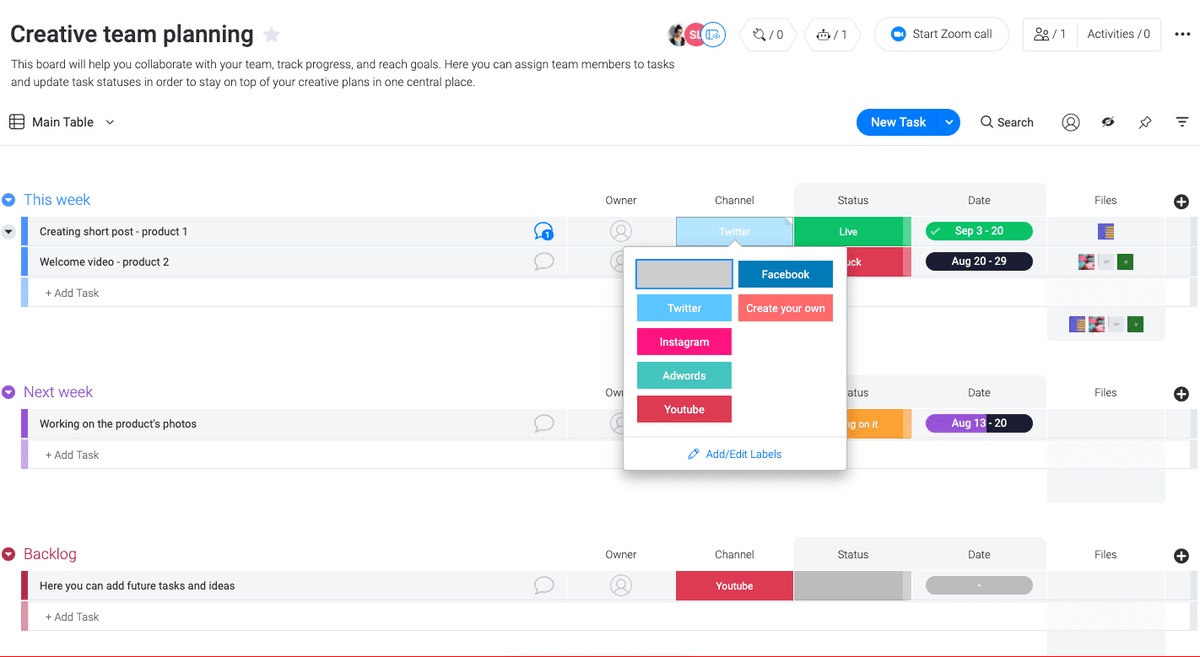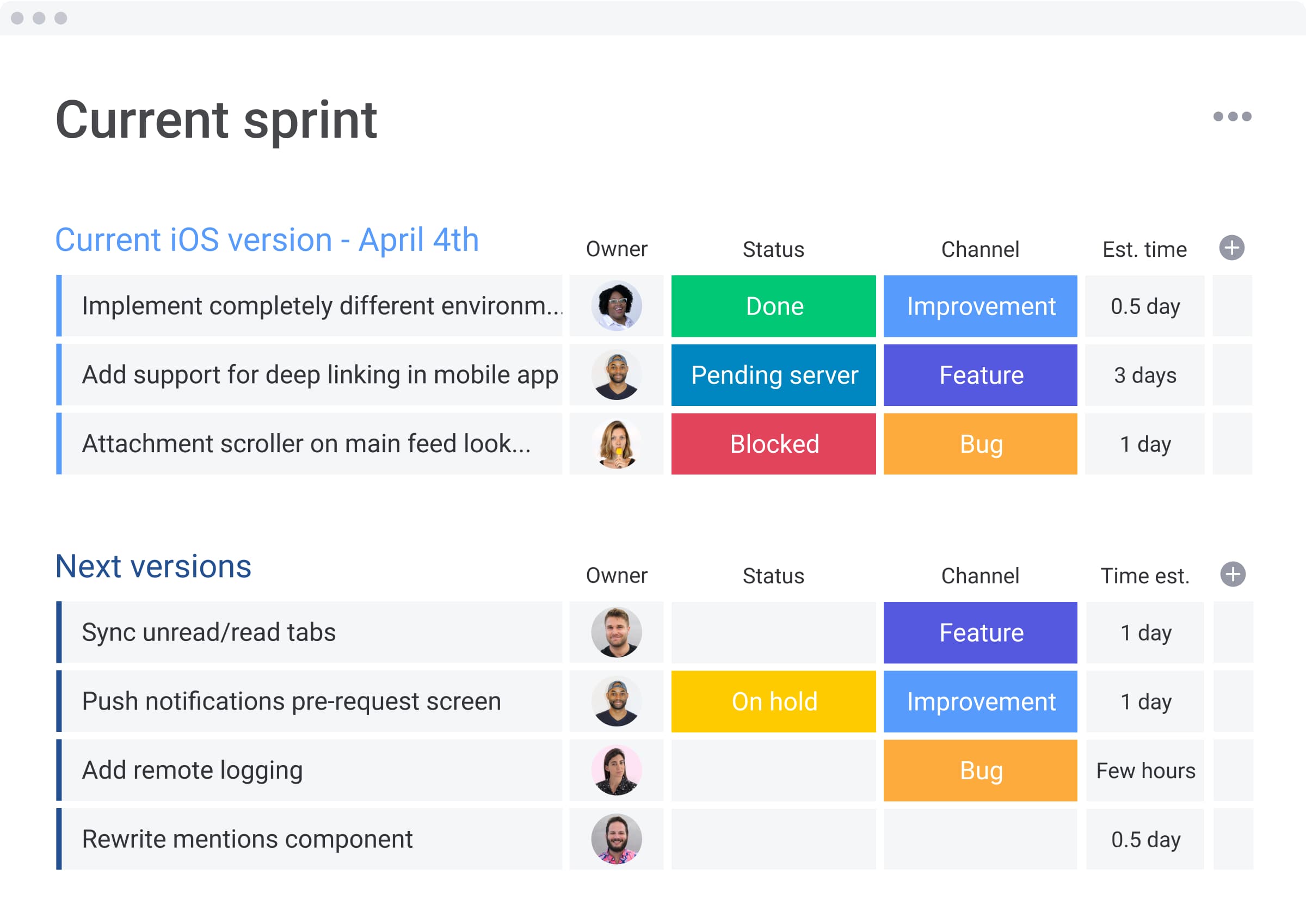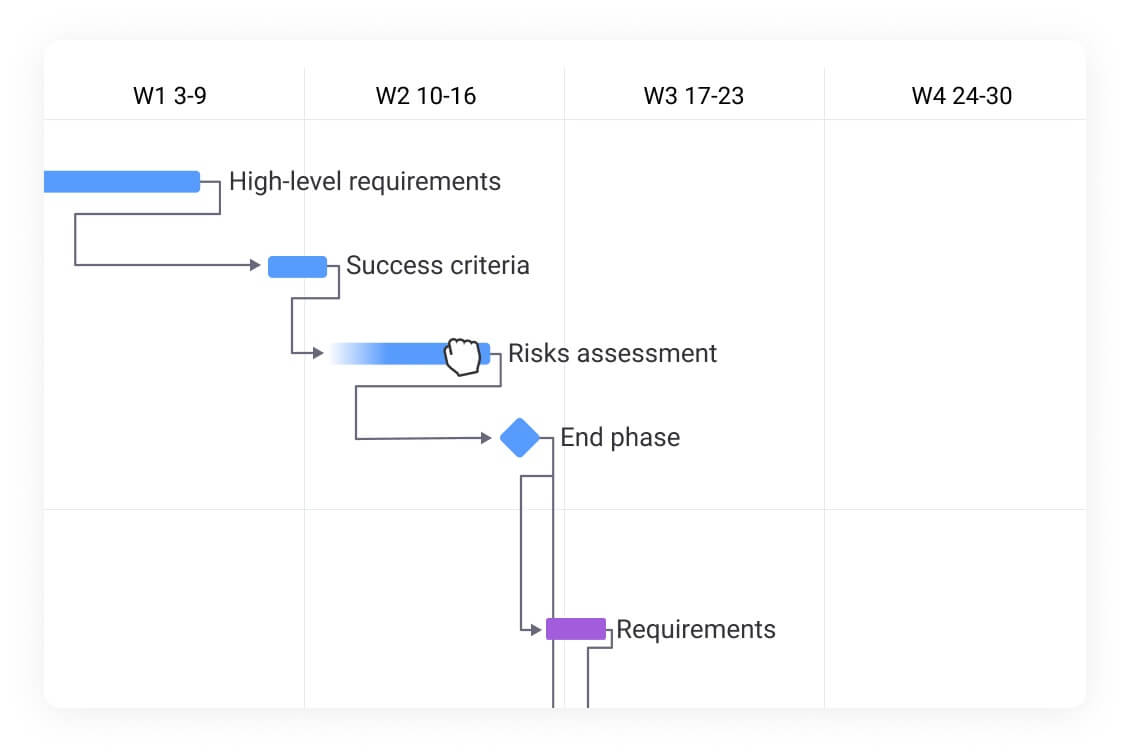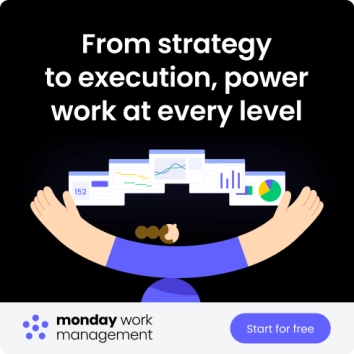Running a marketing team without a creative strategy is like trying to build a house without a blueprint. You might end up with something, but it probably won’t be what you wanted, and a lot of resources will be wasted along the way.
An effective creative strategy ensures every team member understands their role, resources are used wisely, and every asset created directly supports your larger business goals. It’s the bridge between your big ideas and tangible results.
In this guide, we’ll walk you through a step-by-step process for building a creative strategy that works. We’ll also show you how to manage it from start to finish on monday.com and provide a free template to get you started.
Key takeaways
Start with clear goals: define what success looks like before diving into creative production to keep campaigns focused and measurable.
Unite creativity with structure: a strong creative strategy connects your big ideas to practical steps, ensuring every asset serves a business purpose.
Track progress with meaningful KPIs: choose performance metrics that align with your objectives and show real marketing impact.
Collaborate across teams: share your strategy with all stakeholders so messaging, timelines, and budgets stay consistent across every channel.
Bring your strategy to life with monday work management: plan campaigns, assign tasks, and track deliverables in one connected workspace to keep your team aligned from concept to launch.

What is a creative strategy?
A creative strategy is the guiding framework behind every successful marketing or advertising campaign. It defines how a brand transforms ideas into content that connects with the right audience, communicates a clear message, and supports long-term business goals.
At its core, a creative strategy helps teams:
Clarify the message: define what you want your audience to think, feel, or do after engaging with your campaign.
Identify the audience: understand who you’re targeting and what motivates them.
Set the tone and direction: ensure every visual, headline, and asset reflects your brand voice and personality.
Align with business goals: connect creative output to measurable objectives like awareness, engagement, or conversion.
A complete creative strategy also outlines practical details — from the key messaging pillars and creative assets to the chosen marketing channels, estimated budget, and launch timeline. When done right, it gives your team a clear path to follow and ensures that creativity always drives impact.
Is a creative strategy crucial for growth?
In fast-moving marketing environments, every hour and dollar counts. A clear creative strategy ensures that your team’s time, ideas, and resources are focused on the work that drives measurable results. It bridges the gap between creative thinking and business performance, turning bold concepts into campaigns that move key metrics — not just fill timelines.
A well-defined creative strategy also acts as your team’s single source of truth. When designers, writers, and marketers share the same understanding of goals, audience, and messaging, collaboration becomes seamless. Everyone knows what success looks like and how their work contributes to it.
The result? Fewer off-brand ideas, more consistent storytelling, and a creative process that supports growth through clarity, alignment, and confident decision-making.
The 7 key elements of a creative strategy
Before you start building your plan, it’s essential to understand the core building blocks of a creative strategy. These seven elements form the foundation for every successful campaign, helping your team stay focused, aligned, and creative with purpose.
1. A clear business objective
What is the ultimate goal of this campaign? Are you trying to increase brand awareness, drive sales by 15%, or generate qualified leads? Your objective should be specific, measurable, and tied to a larger business need.
2. A defined target audience
Who are you trying to reach? Go beyond basic demographics. Understand their pain points, motivations, values, and where they spend their time online. The more detailed your audience persona, the more effectively you can tailor your message.
3. A thorough competitive analysis
What are your competitors doing? Analyze their messaging, channels, and creative approach. Identify what’s working for them and, more importantly, find the gaps where your brand can stand out with a unique voice and value proposition.
4. The core message and tone of voice
This is the heart of your strategy. What is the single most important thing you want your audience to know or feel? Define your core message and the tone of voice—be it witty, authoritative, or empathetic—that will deliver it most effectively.
5. Key marketing channels
Where will your message live? Based on your target audience research, select the channels where your creative will have the most impact. This could be social media platforms, email marketing, content marketing, or traditional advertising.
6. Key Performance Indicators (KPIs)
How will you measure success? Your KPIs should directly reflect your business objective. For brand awareness, you might track impressions and social media engagement. For lead generation, you’d focus on conversion rates and cost per lead.
7. Budget and resource allocation
What resources do you need to execute your strategy? This includes financial budget for ad spend and tools, as well as human resources like designers, writers, and project managers. A clear budget ensures your creative ambitions are realistic and achievable.

How to build your creative strategy: 6 easy steps to follow
Once you understand the core elements of a creative strategy, it’s time to put them into practice. Building a strategy isn’t just about defining goals — it’s about creating a structured plan that connects creativity with execution. A strong creative strategy provides your team with a clear direction, measurable milestones, and the flexibility to adapt as you learn what resonates with your audience.
Follow these six steps to develop a creative strategy that drives both inspiration and impact.
Step 1: set your goals and objectives
Start by defining what success looks like for your campaign or initiative. Clear goals keep your creative team aligned and focused on measurable outcomes.
Outline the why behind your campaign — what problem or opportunity you’re addressing.
Identify what success looks like (e.g., brand awareness, engagement, lead generation).
Share these goals across your team to ensure complete alignment from the start.
Step 2: research your audience and competitors
Strong creative strategies are built on insight, not assumptions. Dive deep into understanding who your audience is and how competitors are speaking to them.
Use surveys, interviews, and analytics tools to uncover audience motivations and behaviors.
Study competitor campaigns to identify what’s working — and where you can stand out.
Translate these insights into actionable takeaways that guide your messaging and tone.
Step 3: brainstorm your core message and creative concepts
With your goals and audience insights in place, it’s time to translate strategy into ideas that inspire action. Your message should clearly communicate what makes your brand different and why it matters to your audience.
Start by defining your central message — what do you want people to think or feel after engaging with your campaign?
Capture and organize ideas in a shared workspace so everyone can contribute and give feedback in one place.
Use built-in AI features in platforms like monday work management to spark new concepts, refine messaging, or summarize ideas from brainstorming sessions.
By combining collaborative brainstorming with AI-powered support, teams can turn strong ideas into clear creative directions that align with campaign goals.
Step 4: select your channels and create a timeline
Choose where and how your message will reach your audience, then map out the journey from concept to launch.
Match your content format to the channel (for example, short videos for social, long-form for blogs).
Build a campaign timeline that includes milestones, reviews, and delivery dates so your project moves forward smoothly.
Ensure your messaging stays consistent across every touchpoint.
Step 5: define your KPIs and set up tracking
Metrics turn creativity into measurable performance. Establish KPIs that align with your primary goals before launch.
For awareness, track metrics like reach, impressions, and engagement.
For conversions, measure form submissions, downloads, or sign-ups.
Use analytics dashboards or integrated tools to track performance in real time.
Step 6: document and share your strategy
Finally, pull everything together into one clear, accessible document that serves as your creative blueprint.
Include your goals, audience insights, messaging, visuals, and KPIs.
Store it in a shared workspace so every stakeholder can reference it easily.
Keep it as a living document — update it as campaigns evolve or new data comes in.
When your creative strategy is clear, collaborative, and measurable, your team can move from concept to execution with confidence — and your marketing becomes more intentional, efficient, and impactful.

Real-life creative strategy examples
Seeing how other brands approach creative strategy can make the process feel more achievable. Whether you’re building awareness, launching a new product, or rebranding, the same principles apply — clear goals, consistent messaging, and measurable results.
Here are a few examples of how teams put creative strategy into action.
Example 1: building awareness through storytelling
A global nonprofit wanted to increase awareness around its new sustainability initiative. The team created a creative strategy focused on human storytelling — spotlighting the people directly impacted by their work rather than the organization itself.
Goal: increase campaign reach and emotional engagement.
Approach: used audience research to identify high-impact narratives and consistent visual themes.
Result: a 45% rise in engagement across social channels and higher donor retention rates.
Example 2: launching a product with a unified campaign
A tech startup preparing to launch a new productivity app used its creative strategy to align marketing, design, and sales teams.
Goal: drive early adoption through trust and clarity.
Approach: built a core message around “simplifying everyday work,” tested it across ad copy, video, and web content, and tracked response through A/B testing.
Result: the app hit its first-quarter signup target within six weeks and gained strong user reviews for brand consistency.
Example 3: refreshing a brand through visual identity
An established retail company used its creative strategy to reposition itself as a modern, community-focused brand.
Goal: appeal to younger audiences without losing loyal customers.
Approach: defined new messaging pillars and visual guidelines, then rolled them out across social content, email, and packaging design.
Result: a measurable uplift in brand sentiment and a 20% increase in repeat customers within the first quarter.

Bring your creative strategy to life with monday work management
A great creative strategy doesn’t end with planning — it succeeds through execution. With monday work management, marketing and creative teams can manage campaigns from concept to delivery in one connected workspace. From ideation to approvals and reporting, everything stays transparent, aligned, and measurable.
Centralize planning with Workdocs
Draft, refine, and finalize your creative strategy directly in Workdocs. Collaborate in real time as your team:
Brainstorms ideas and outlines key messaging.
Embeds boards, dashboards, and assets for full context.
Collects feedback from stakeholders in one place.
With shared access, everyone stays aligned before kickoff, reducing confusion and last-minute changes.
Visualize timelines with Gantt charts
Turn your campaign plan into a visual timeline using Gantt charts. You can:
Set task dependencies and assign owners.
Track progress against milestones.
Identify bottlenecks early to stay on schedule.
This high-level view helps project managers anticipate challenges and manage resources efficiently.
Track performance with customizable dashboards
Monitor campaign performance in real time using customizable dashboards. Pull data from multiple boards to view KPIs, budgets, and workloads at a glance.
Build data-driven insights into creative performance.
Share dashboards with stakeholders for instant transparency.
Streamline creative requests with Forms
Keep creative intake organized with customizable Forms. When a form is submitted, a new item is automatically created on your team’s board — complete with all the necessary details — so you can focus on creating instead of chasing information.
Automate approvals and handoffs
Save time and reduce manual work by automating repetitive steps in your creative process.
Trigger notifications when assets are ready for review.
Move approved work to the next stage automatically.
Keep every stakeholder informed in real time.
By combining structured workflows, collaboration tools, and automation, teams can transform creative strategies into actionable results — keeping every project on track and every campaign aligned from start to finish.
Ready to bring your next campaign to life?
FAQs
What is the difference between a creative strategy and a marketing strategy?
A marketing strategy is the overall plan for reaching business goals, outlining which markets to target and how to position the product. A creative strategy is a component within that plan, specifically focused on what the messaging will be and how to deliver it. Think of the marketing strategy as the 'what' and 'where,' and the creative strategy as the 'how' and 'why' behind the communication.
What are the key components of a creative brief?
A creative brief is a document used to guide the development of a specific creative asset or campaign. Its key components typically include the project background, the primary objective, the target audience, the core message, tone of voice, key deliverables, call to action, and any mandatory elements like brand guidelines or logos.
How do you measure the success of a creative strategy?
The success of a creative strategy is measured against the Key Performance Indicators (KPIs) defined in the planning stage. These metrics should directly tie to your business objectives. For example, success could be measured by brand uplift surveys, website traffic, social media engagement rates, lead generation numbers, or ultimately, sales revenue attributed to the campaign. Using tools like monday.com Dashboards helps track these KPIs in real-time.
 Get started
Get started 


